“Day of the Dove”
Written by Jerome Bixby
Directed by Marvin Chomsky
Season 3, Episode 11
Production episode 60043-66
Original air date: November 1, 1968
Stardate: unknown
Captain’s log. Kirk, McCoy, Chekov, and Lieutenant Johnson from security beam down to Beta XII-A, phasers ready, responding to a report of a human colony being attacked by an unknown ship. But Chekov detects no sign of the colony nor of any sign that it was destroyed, or even that it ever existed, and McCoy reads no life signs.
Then Spock calls from the Enterprise—there’s a Klingon ship approaching. However, Sulu scans the Klingon ship and discovers that it’s disabled, with multiple explosions. Commander Kang beams down with a landing party and strikes Kirk, accusing him of firing on his ship and disabling it, while Kirk accuses Kang of destroying the colony on the planet.
And even as Kirk and Kang confront each other, there’s this swirly thing floating nearby…

The Klingons on the planet have the upper hand, and Kang orders Kirk to surrender his ship to Kang. Kirk refuses, so Kang offers to torture the members of the landing party one by one. Chekov volunteers to go first by accusing the Klingons of killing his brother Piotr, one of a hundred killed on Archanis IV.
One of Kang’s officers tortures Chekov until Kirk gives in and agrees to call the ship. Kang urges Kirk not to try anything crazy, and Kirk says he’ll beam them on board—once there, no tricks. Kang fails his saving throw versus “clever wordplay” and agrees. Kirk orders Spock to beam everyone up in a wide field, but also covertly signals him. Scotty beams the landing party up, but holds everyone not in the party in the transporter buffer until Johnson can summon two more security guards. Kang and his people materialize and are taken prisoner. Kirk also beams the remaining survivors off of Kang’s disabled ship, including his wife and science officer, Mara. Mara expects them to be tortured, but Kirk surprises them by confining them to the crew lounge and ordering the food synthesizers to be programmed to suit their needs. (Given what we found out about Klingon food in TNG‘s “A Matter of Honor” and beyond, it’s probably for the best that we didn’t get a lunch scene.)
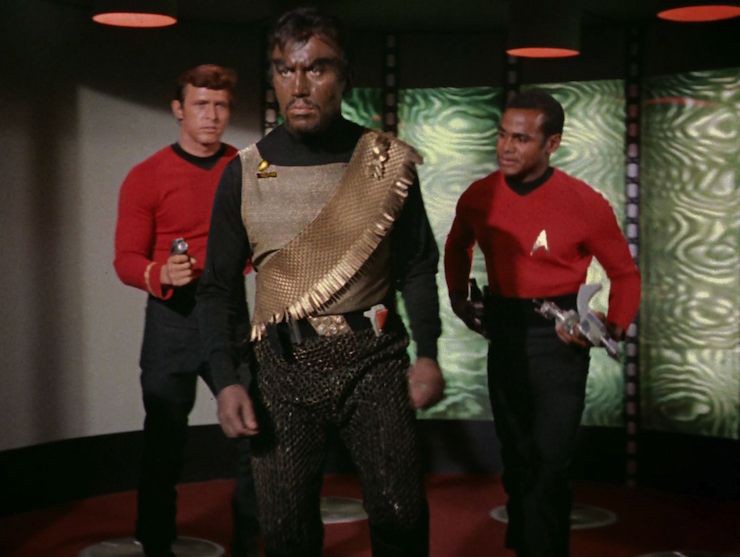
Kirk orders the sector searched, as they still don’t know what actually happened to the colony. Spock points out that Kang’s ship was too far away to have been responsible. Chekov and McCoy, though, are sure the Klingons are involved, and both of them are way more bloodthirsty on the subject than usual.
On the bridge, Uhura reports that they can’t get through to Starfleet Command. Sulu scuttles the Klingon ship for reasons that are never made clear, then they leave orbit.
The swirly thing is now on board, and gadding about the ship.
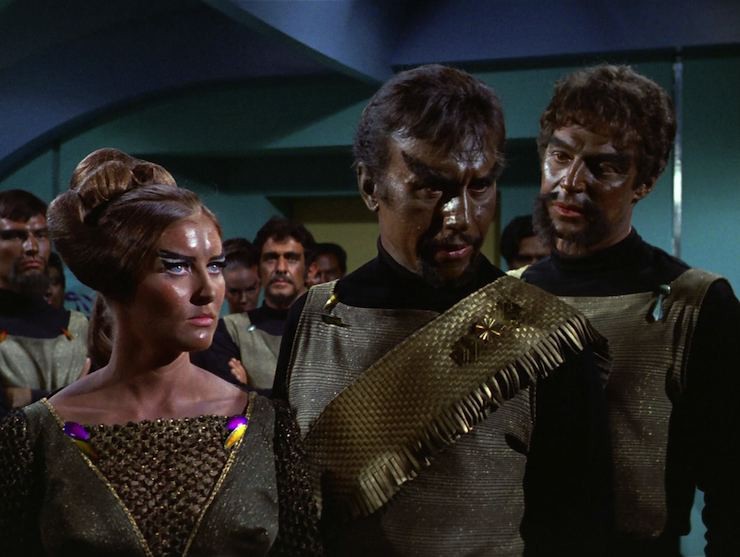
In the crew lounge, Kang still plans to take the Enterprise, unconcerned with the fact that they are forty against four hundred.
Back on the bridge, Uhura still can’t get through to anyone, and then the Enterprise suddenly changes course: neither Sulu nor Scotty can get control of the ship, which is now hurtling out of the galaxy at warp nine. Uhura reports that emergency bulkheads have closed all over the ship, trapping 392 of the crew. Kirk immediately goes to Kang, who is amused at being accused of sabotage he could not possibly have performed while trapped in the lounge.
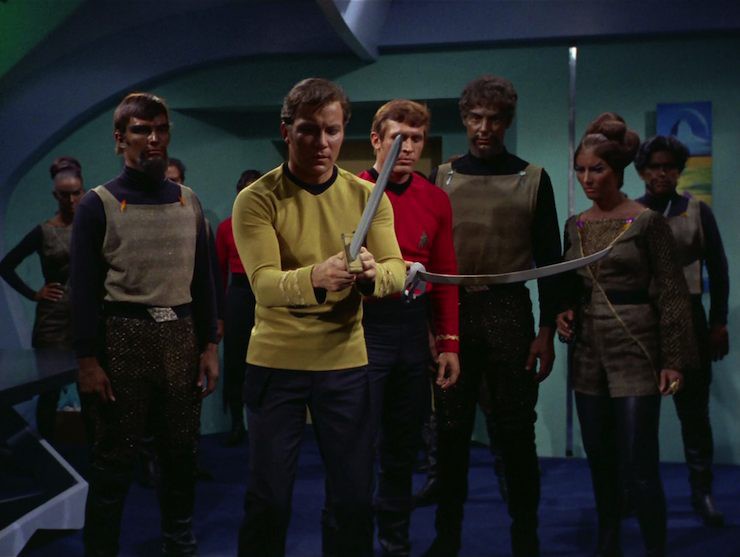
Suddenly, various items in the lounge transform into swords—as do the phasers held by Kirk, Johnson, and the other security guards. A melee ensues, with Johnson badly wounded. He’s taken to sickbay while Kirk reports to the bridge, the Klingons now free to roam the ship, the Starfleet crew now also all armed with blades.
Spock points out that neither they nor the Klingons have the technology to transmute matter like this. Plus, even if it was the Klingons, why give the Starfleet crew the same weapons?
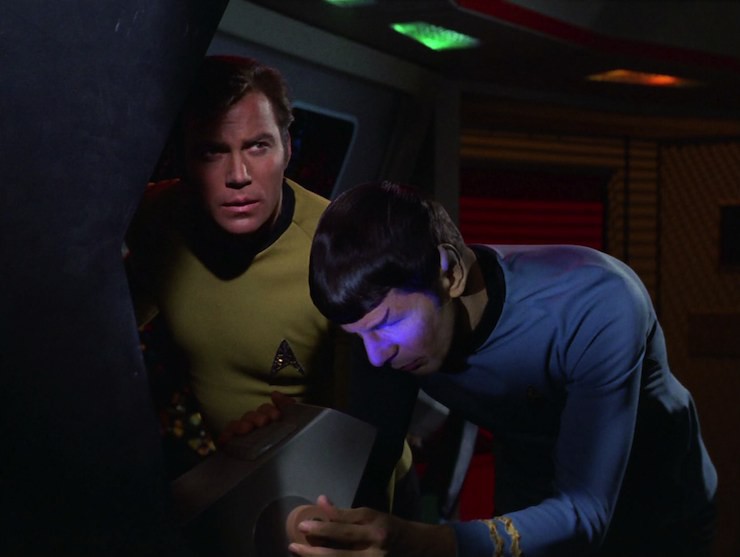
Chekov leaves his post, hungry for revenge for his brother Piotr—except after he leaves, Sulu says that Chekov’s an only child. Spock also detects an alien life force on board, and it’s probably responsible for everything that’s happening that doesn’t make sense. McCoy comes to the bridge and goes on a very un-McCoy-like harangue about how they should wipe out all the Klingon murderers and how Kirk and Spock need to act like military men.
Scotty checks the armory, only to find that the phasers have been replaced by more bladed weapons. He grabs himself a Claymore…
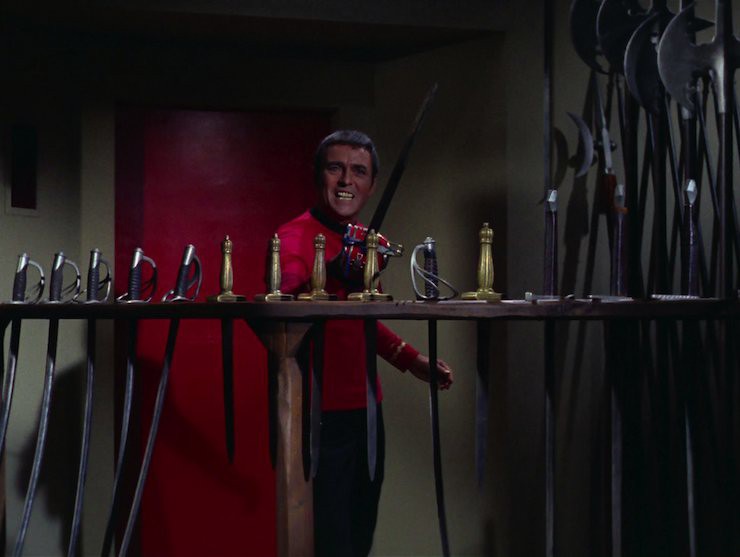
Kang’s people take over engineering and shut off life support to the rest of the ship. Scotty reports to the bridge and goes on an anti-Klingon rant that then becomes an anti-Vulcan rant against Spock, at which point Spock and Scotty almost come to blows. Kirk manages to get everyone under control, and is more determined than ever to find the alien.
Then life support comes back online. Sulu has no idea how it happened, and neither does Mara. Kang, frustrated at the power that supports their battle but starves their victory, sends Mara to physically cut off the life support systems on deck six.
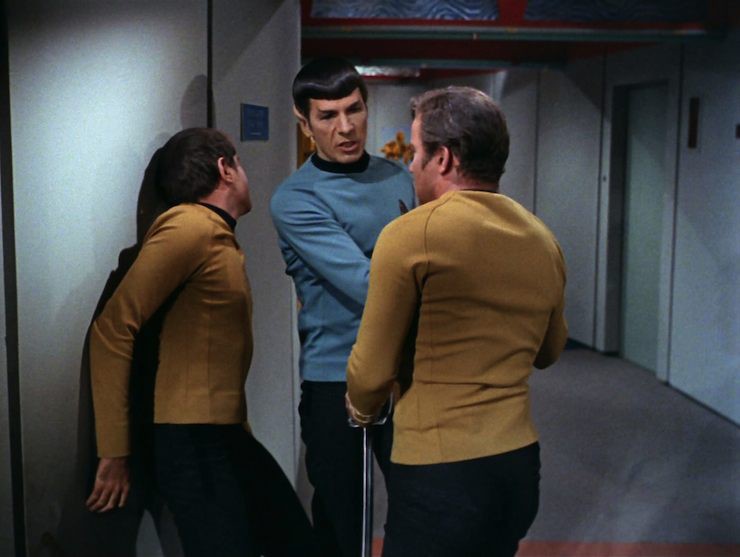
However, she runs into Chekov, who kills her escort, and then decides that Mara’s reeeeeeal purty and starts to sexually assault her. Kirk sees this and promptly beats the shit out of him before Spock stops him.
Kirk tries to appeal to Mara to help them stop the alien, but Mara says nothing in reply, refusing to cooperate. They bring her and the now-unconscious Chekov to sickbay. McCoy reveals that all his patients’ wounds are healing on their own—the swirly thing is keeping the numbers consistent and equal.
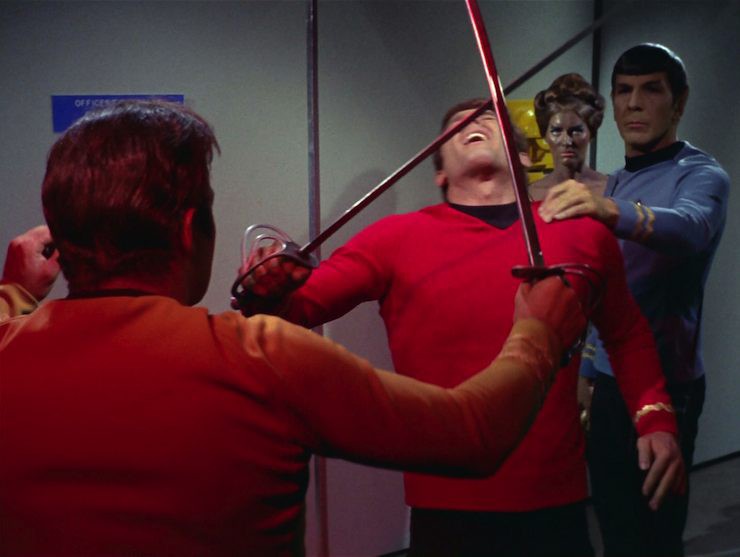
In the corridor, Kirk, Spock, and Mara see the swirly thing. Kirk tries talking to it, but then Johnson shows up, having checked himself out of sickbay, and insists on killing the Klingons no matter what. He refuses Kirk’s orders to stand down, and then attacks Kirk, though Spock is able to neck-pinch him.
Spock reports that the swirly thing’s energy level increased when Johnson was ranting and raving, then decreased when Johnson fell unconscious. Kirk and Spock hypothesize that it feeds on hatred, and also has created a situation that allows it to maintain a constant state of violence: edged weapons that are more brutal, exacerbating race hatreds, keeping resources and numbers equal.

Kirk contacts Kang, who refuses to even speak to Kirk. Scotty reports that the dilithium crystals are deteriorating. Soon the ship will be adrift. Reluctantly, Kirk tries to use Mara’s life as leverage, but Kang calls the bluff, saying that Mara is a victim of war, and she understands. (No one mentions the fact that Kirk could kill Mara all he wants, she’s gonna come back…)
When Mara realizes it’s a bluff, she agrees to help Kirk to convince Kang of the truth. Kirk and Mara beam directly to engineering. Mara tries to get Kang to listen to reason, but he refuses (the torn tunic doesn’t help). Kirk and Kang clash swords, but only the sight of the alien gives Kang pause. Finally, Kirk throws away his weapon and tells Kang to kill him—it won’t matter, he’ll be resurrected to keep fighting. Mara insists that she would never lie for Kirk.

Finally, Kang tosses his weapon aside, saying Klingons kill for their own reasons, not somebody else’s.
Kirk has Uhura put them on shipwide, and both Kirk and Kang declare hostilities to cease. Everyone stops fighting. Then, at Spock’s suggestion, they engage in good spirits to help drive it out. Kirk and Kang laugh with each other (Kang slapping Kirk hard enough on the back to cause Kirk to stumble forward a foot) and the swirly thing leaves, denied its lunch.
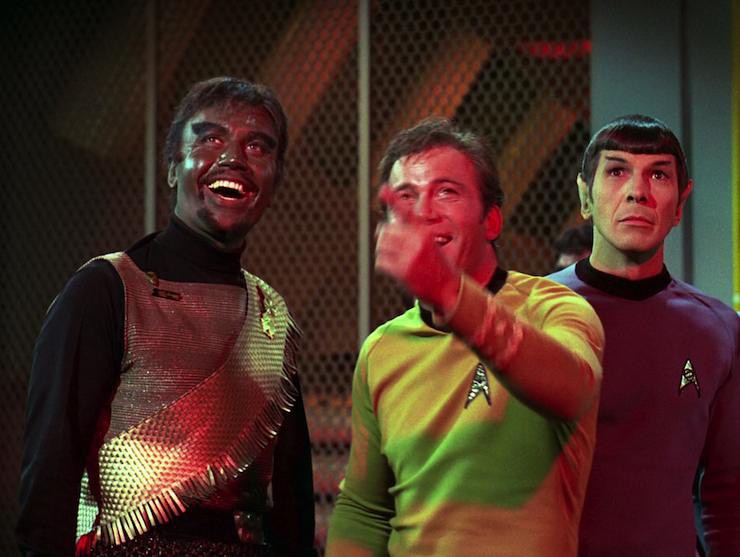
Can’t we just reverse the polarity? Kirk and Mara go to engineering by beaming there from the transporter room. Intraship beaming is described by Spock as risky, and this is the only time it is attempted on the original series. By the 24th century of the first three spinoffs, it will become commonplace.
Fascinating. Fittingly, Spock’s version of getting “angry” is to talk in a much lower monotone than usual and then try to pound Scotty on the head.
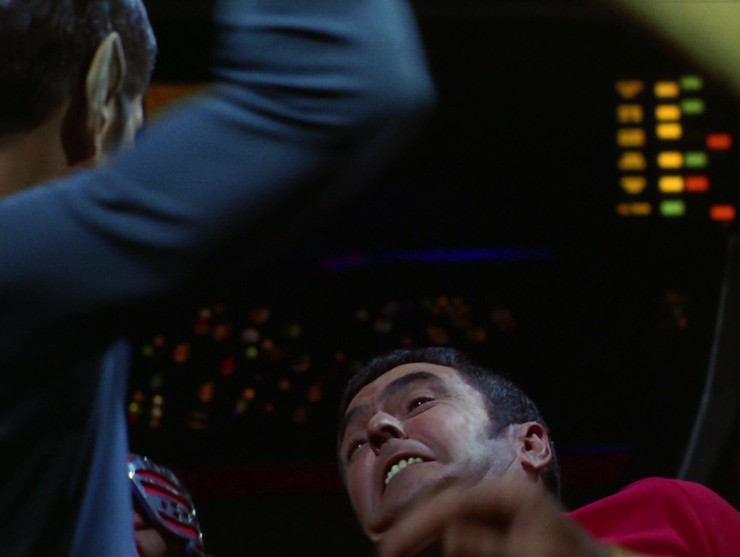
I’m a doctor not an escalator. McCoy, upon realizing that they’re being manipulated by the swirly thing, abashedly apologizes for his bloodthirsty ranting and raving on the bridge.
Ahead warp one, aye. This is the second time Sulu gets to wield a sword, both times due to external factors forcing him into it, though at least he’s in his right mind, unlike in “The Naked Time.” While swordfighting will be part of Sulu’s character in many works of tie-in fiction, the character won’t be seen wielding a sword again until the 2009 Star Trek.
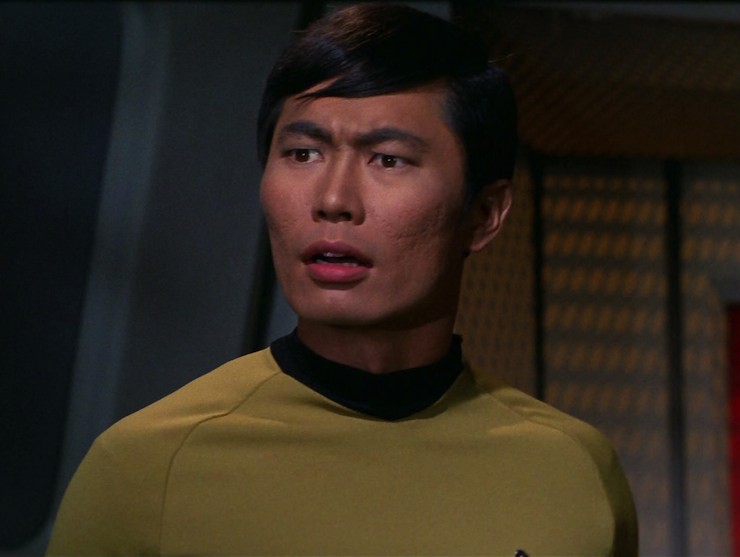
He’s also the only speaking crew member who is never seen to be affected by the swirly thing.
It is a Russian invention. It is established that Chekov is an only child, which is why the swirly thing invents a dead brother for him to grieve over.

Hailing frequencies open. The swirly thing only affects Uhura insofar as it makes her frustrated with her inability to communicate with anyone outside the ship.
I cannot change the laws of physics! Scotty has an affection for Claymores and is turned into a racist by the swirly thing, referring to Spock as a green-blooded halfbreed, urging him to transfer out, and calling him a freak.

Go put on a red shirt. Thanks to the swirly thing, redshirts can die and come back! It’s like Christmas!
No sex, please, we’re Starfleet. The swirly thing, in addition to giving Chekov a phantom dead sibling, also turns him into a rapist.
Channel open. “You killed my brother!”
“And you volunteer to join him. That is loyalty.”
Chekov wanting vengeance, and Kang accepting the offer.

Welcome aboard. Susan Howard plays Mara, the first Klingon woman we’ve seen on screen, while Mark Tobin plays another Klingon. David L. Ross, having been killed as Galloway in “The Omega Glory,” comes back as a totally different security guard named Johnson in this one. (He’ll be back as Galloway, miraculously resurrected, in “Turnabout Intruder.”) And we have recurring regulars George Takei, Nichelle Nichols, James Doohan, and Walter Koenig.
But the big guest is the great Michael Ansara bringing tremendous gravitas to the role of Kang, a role he inhabited so perfectly that he was asked back twice to reprise the role, in DS9‘s “Blood Oath” and Voyager‘s “Flashback.”
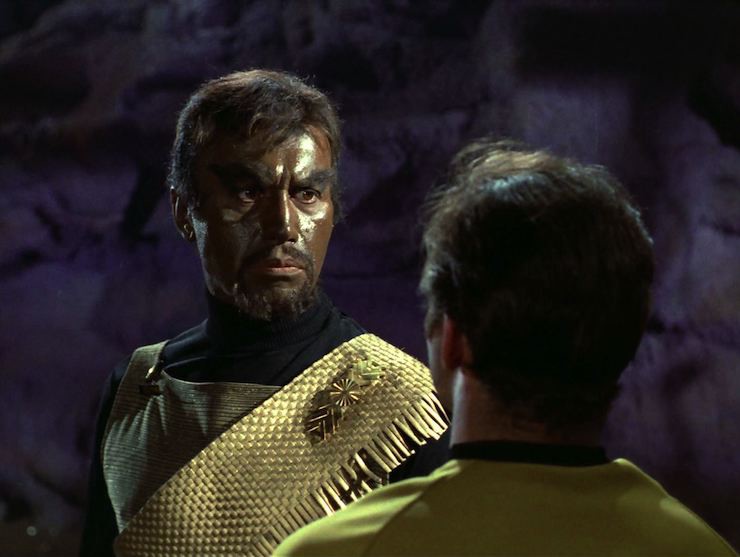
Trivial matters: Jerome Bixby’s script originally called for Kor from “Errand of Mercy” to return, but John Colicos was busy filming Anne of the Thousand Days and was unavailable, so the role of Kang was created. Kor and Kang (and Koloth from “The Trouble with Tribbles“) would later be established as old friends in DS9‘s “Blood Oath.”
This episode establishes the Klingons’ preference for bladed weapons, which will become even more codified in the spinoff series, and also their predilection for hunting. Two lines from the episode also become known in tie-in fiction as Klingon sayings: “four thousand throats may be cut in a single night by a running man” and “only a fool fights in a burning house.”
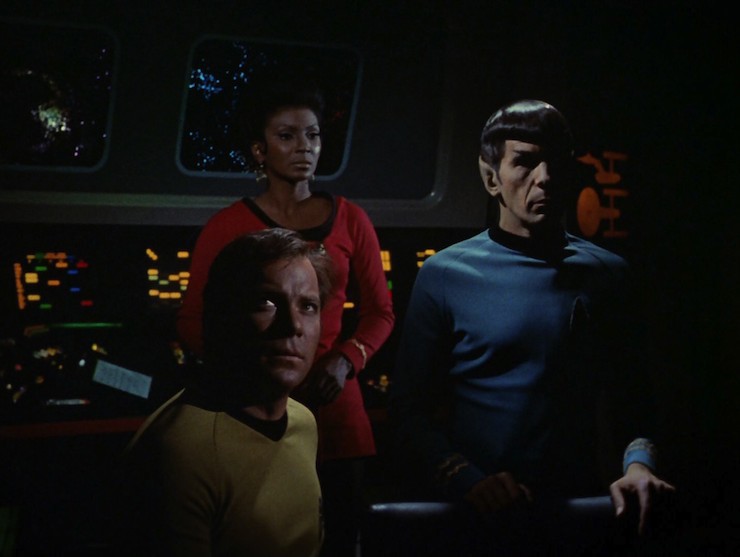
In addition to the adaptation by James Blish in Star Trek 11, this episode got the fotonovel treatment, complete with an interview with Michael Ansara.
We see this episode from the perspective of Kang and his crew in the comic book Blood Will Tell #4 by Scott & David Tipton and David Messina. That comic established that Kang’s ship that was destroyed at the top of the episode was called the Voh’tahk and also named much of Kang’s crew. Your humble rewatcher used the crew established in that story in his and J.K. Woodward’s comic Alien Spotlight: Klingons (which focused on Kang, and which has “four thousand throats may be cut in a single night by a running man” as its theme), and again in his novella “The Unhappy Ones” in Seven Deadly Sins.

Among the many other tie-in appearances by Kang: Pawns and Symbols by Majliss Larson; the My Brother’s Keeper trilogy by Michael Jan Friedman; Forged in Fire by Andy Mangels & Michael A. Martin; the Seekers series by David Mack, Dayton Ward, & Kevin Dilmore; Traitor Winds by L.A. Graf; Mere Anarchy: The Blood-Dimmed Tide by Howard Weinstein; issues #77-80 of DC’s second monthly Star Trek comic by Kevin Ryan, Rachel Ketchum, and Steve Erwin; “A Bad Day for Koloth” by David DeLee in Strange New Worlds 9; and your humble rewatcher’s The Art of the Impossible and The Klingon Art of War.
The swirly thing will reappear in two works by Greg Cox: The Q-Continuum trilogy, which gives the creature’s origin, and the short story “Night of the Vulture” in Tales of the Dominion War, which has the creature having a blast during that 24th-century war.
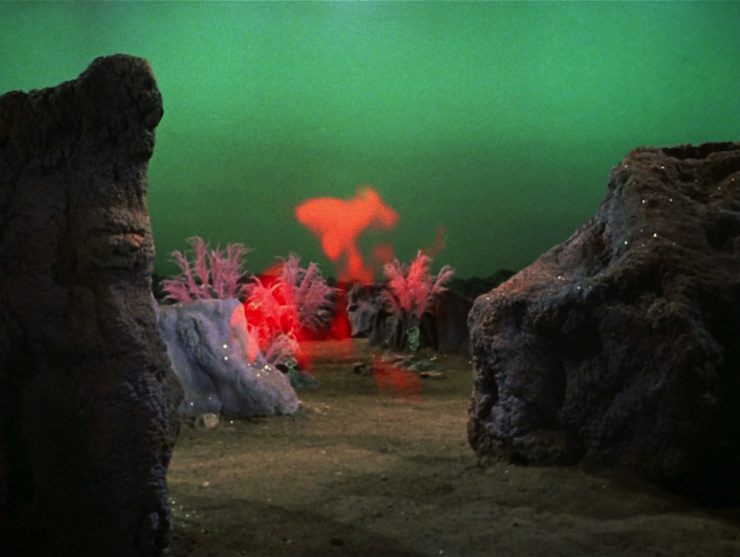
Kang references the treaty between the Klingons and the Federation, established in “The Trouble with Tribbles” as the Organian Peace Treaty, signed following “Errand of Mercy.” He also says 1) that it was three years previous, when it was only about a year and a bit, but whatever and 2) that the Klingons have observed the treaty “to the letter,” which is a generous interpretation of Arne Darvin’s sabotage in “Tribbles.”
Kang tells Kirk that the Klingons have no devil, though TNG‘s “Devil’s Due” will establish that there is a kind of Klingon devil, Fek’lhr (though Fek’lhr is more like Charon than Lucifer), and Kor will use the phrase “deal with the devil” when speaking to Kang in “Blood Oath.”
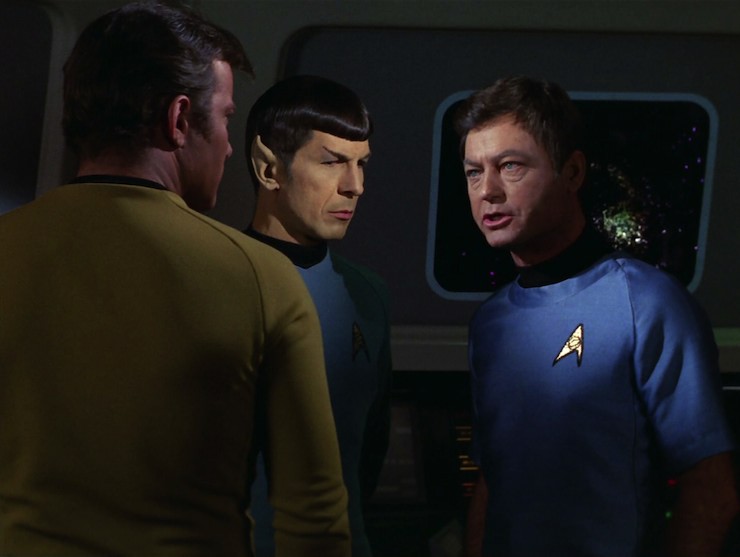
To boldly go. “We need no urging to hate humans!” I have written a rather absurd amount of Klingon fiction over the years, starting with my first-ever Trek novel, Diplomatic Implausibility, which primarily took place on a Klingon ship, all the way to my most recent Trek fictional work, The Klingon Art of War. I have a great fondness for Klingons, one that goes all the way back to, well, this very episode, and it’s primarily due to Michael Ansara’s Kang.
Good antagonists are important in dramatic fiction, because unworthy antagonists make for weak protagonists. Strong bad guys make the good guys’ victories that much more impressive and sweeter. In Kang, we have the Klingon equivalent of Kirk. He’s smart, stubborn, clever, determined, thoughtful, and he’s got the best voice ever.
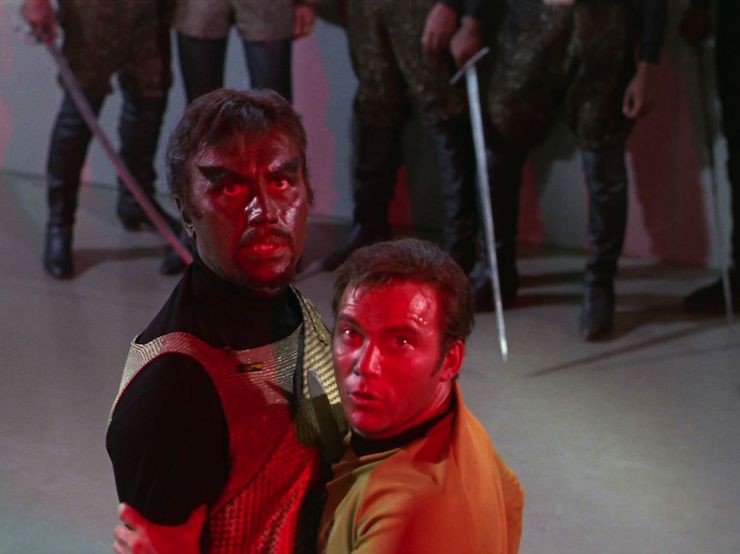
Way back when I was first watching Trek as a little kid in reruns on Channel 11 in New York City, I remember being utterly captivated by Kang, precisely because I actually believed he could take over the Enterprise, that he could beat Kirk. He was just that much of a badass. He wasn’t played as just a dumb savage, in particular at the climax where you can see the wheels turning as the swirly thing goes red and Kirk and Mara try to talk sense into him.
Once again, we have a script that takes the razed budget of the third season and puts it to good use. The contrivances of the story are actually made part of the story—specifically arranged by the swirly thing to further its agenda. So the limited number of crew, the edged weapons (no special effects!), the use almost entirely of standing sets (plus the generic empty planet set), it’s all in service to the plot while still saving money.
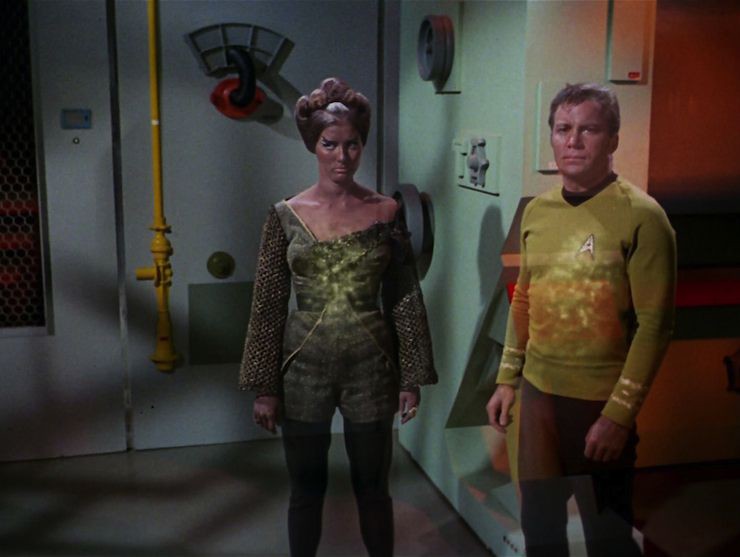
It’s easy to lose track of Susan Howard, trapped as she is in the shadow of Ansara’s magnificence, but that does a disservice to Howard’s Mara, who follows very nicely in the footsteps of Miranda Jones and Natira (and, to a much lesser degree, of Elaan, Miramanee, Gem, and the Romulan commander) of strong female characters in this third season. Mara’s refusal to talk to Kirk until Kang calls his bluff of killing Mara is beautifully played by Howard, her facial expressions showing the character’s defiance, her curiosity, and her confusion. Just a superlative performance, with the only sop to her gender being Chekov’s awful attempted rape—which is shown as yet more deviant behavior alongside Spock and Scotty’s bigotry and McCoy and Johnson’s bloodthirstiness.
The episode’s primary flaw is in the main actors’ inability to convincingly be assholes. DeForest Kelley, William Shatner, David Ross, and James Doohan all are incredibly artificial in their craziness. Yes, it’s imposed from the outside, but that shouldn’t make it unconvincing. The exceptions are Leonard Nimoy, who wisely underplays it, and Walter Koenig, who actually is quite effective as a revenge-crazed rapist and murderer. (Certainly more so than he was as an ambitious snot in “Mirror, Mirror.”)
Warp factor rating: 9
Next week: “Plato’s Stepchildren”
Keith R.A. DeCandido will be Author Guest of Honor at Ro-Con 2 in Mystic, Connecticut this weekend, alongside Local Media GoH Chion Wolf, Metageek GoH Jeff Mach, Science GoH Ken Fink, and Guest of Awesome D.L. Carter. Keith will be selling and signing books and also doing programming. His full schedule is here.










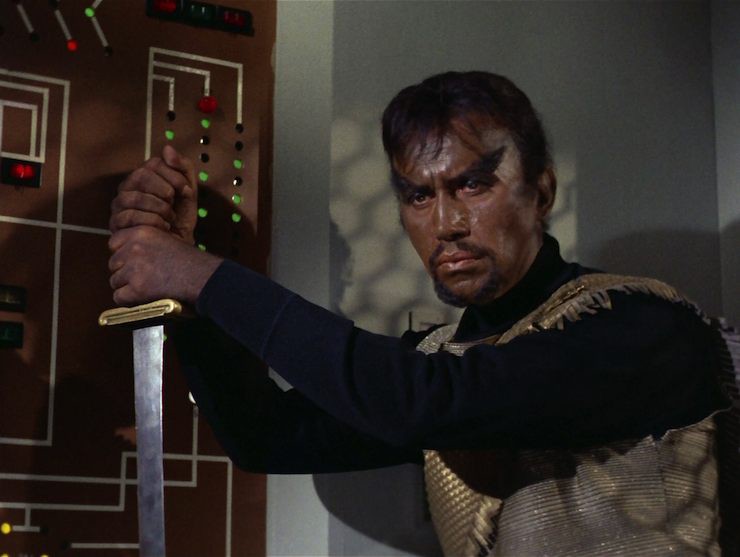
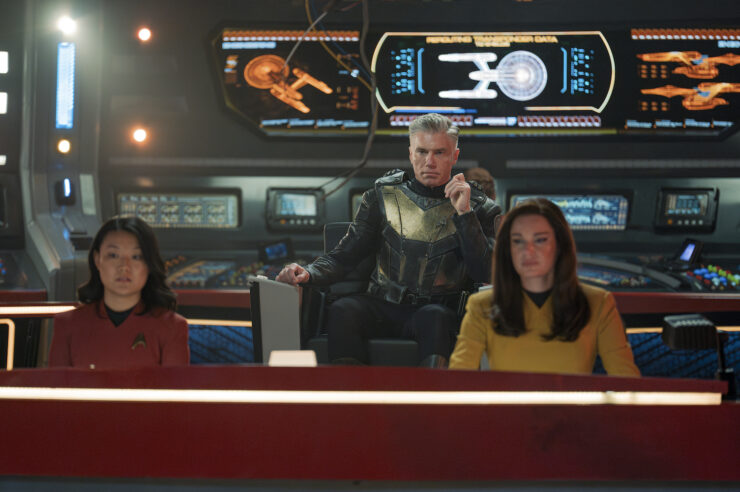
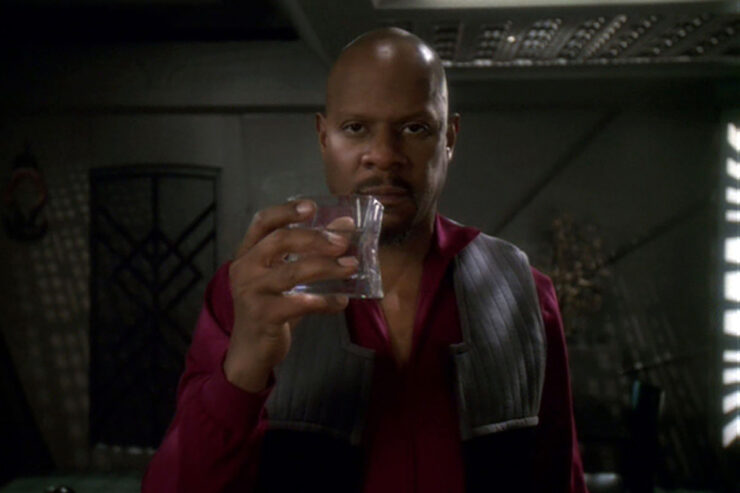

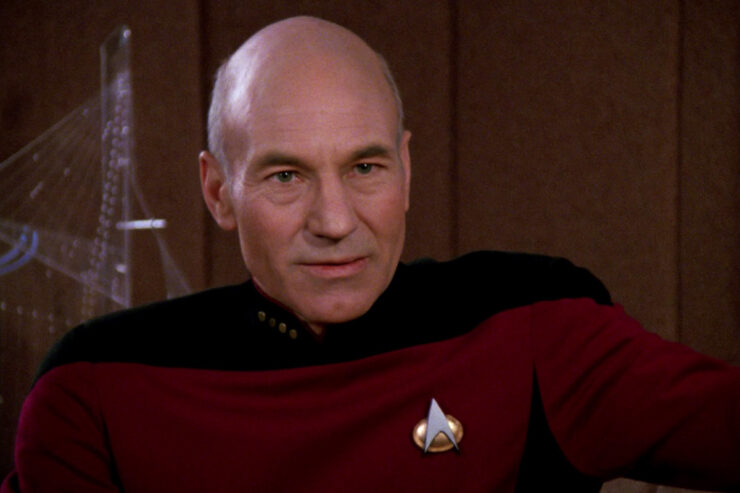
I did not remember that Kang wore the same sash (I presume) as Kor and Worf. Very cool.
The “three years” comment seems easily dealt with by assuming we’re not seeing every single adventure the Enterprise has during the five year mission, and that rather than taking place a year-and-a-half after “Errand,” as it does in mudane real world time, this is sometime during the Enterprise’s late fourth or early fifth year out. Maybe? At any rate, it was good of them to try for internal continuity.
Mara is a great character (and clothing her in a proper and dignified uniform makes the absurd focus on the Duras’ sisters cleavage in TNG all the more ridiculous – although I suppose that could be their personal choice. Maybe?)
Great write-up of a strong epsiode!
Also worth mentioning that, as with “A Private Little War” and the mugato, high-def does this episode no favors, as the dark makeup on the Klingons (especially Ansara and Howard) looks very little like a fleshtone and very much like a person caked in makeup.
—Keith R.A. DeCandido
@1/Mike – “Mara is a great character (and clothing her in a proper and dignified uniform makes the absurd focus on the Duras’ sisters cleavage in TNG all the more ridiculous – although I suppose that could be their personal choice. Maybe?)”
Nah, it still makes the focus ridiculous; fictional characters only have the preferences writers give them, after all. :P
It’s also nice that Mara isn’t the only Klingon woman in the landing party.
One slight nit: it’s “intraship”, not “intership”. “Intership” would be beaming from one ship to another. Clearly, they were better at intraship beaming in the 24th century, although it does make one wonder why they didn’t try it in The Naked Time rather than spend time trying to cut through to engineering.
I liked this episode, except that it has one plot weakness on the part of the swirly thing (or (*) to use Greg Cox’s name for it). It made one unexplainable mistake that allowed the good guys to win. It allowed itself to be seen.
Just how do they decide what a year is between Star Trek cultures anyway? Maybe the Klingon home world spins around its sun faster than Earth. That’s in my head canon anyway.
The words “Duras Sisters” and “dignified” don’t go together. Not an honorable one in that family.
richf: gah! Stupid typos…..
—Keith R.A. DeCandido
Did the * change the swords back to phasers, etc., or did the Enterprise have to visit a starbase to restock?
Were the main phaser banks transformed into a battering ram? Torpedo launcher(s) into a trebuchet?
I am remembering the 3rd season was not that bad, chiefly because of very good guest stars/ characters and poverty- influenced clever storytelling mentioned.
The essentially blackface makeup in this episode is gross. A particular shame as, IIRC, it’s otherwise one of the better Klingon episodes.
Ahh, “swirly thing.” The Red Dwarf school of cosmic phenomenon nomenclature. I tend to think of it as the Evil Pinwheel Thingy, because that’s what the special effect basically is — just a Mylar pinwheel double-exposed onto the film.
The plot is contrived as hell, and the alien’s powers are random in a way that’s quite typical of Fred Freiberger-produced sci-fi (season 2 of Space: 1999 gave its aliens even more random, gratuitous, and borderline-magical powers than season 3 of TOS did, with teleportation inexplicably being the most frequent recurring power). I have to wonder, does the energy the entity absorbs from the, err, emotional emanations of the crew really outweigh the amount of energy it must expend in transmuting matter and resurrecting the dead? I don’t think that really adds up. (And how exactly do entities like this and Redjac feed on emotion? How does emotion generate any kind of energy besides the heat given off by a heightened metabolism? And why does it have to be specific emotions like fear or hate? How does such a feeding method even evolve?)
But the episode works wonderfully, not only due to Michael Ansara’s compelling presence but also to Jerome Bixby’s beautiful, lyrical dialogue. It’s also a nice little statement against war and bigotry, although a bit blatant about it, as was also typical of season 3.
As for Chekov’s rape attempt, I don’t really fee it’s as gratuitous as it might’ve been in a different story. After all, rape has always been used as a weapon of war, a tool of torture, and a means of dehumanizing and demoralizing an enemy or enslaved population. So it fits right into the episode’s theme about the horrors of war and race hatred being induced in microcosm, and into the idea that the entity was trying to make the conflict as brutal and traumatizing as possible.
I believe this is the first time we saw background Klingons with facial hair. In “Errand of Mercy,” only Kor and his lieutenant had goatees, in “Tribbles” it was just Koloth and Korax, and the other Klingon episodes had only one Klingon each. After TOS, though, I don’t think we’d see another smooth-faced adult male Klingon until Alexander Rozhenko in DS9, and then not again until Star Trek Into Darkness.
Oh, and you didn’t need HD to see that the pancake makeup on the Klingons in this episode was unconvincing. I recall noticing it long ago, when watching the standard-definition syndicated episodes on TV. It’s really, really noticeable at Susan Howard’s hairline. Maybe they should’ve given her bangs…
I’ve never really cared for the idea that the memorable lines from this episode were established Klingon sayings rather than extemporaneous statements by the characters. I mean, the “four thousand throats” line in particular comes after a line about forty people versus four hundred, which suggests it was made up on the spot rather than being a saying that coincidentally happened to have the next number in the sequence already built into it. At the very least, it should’ve been the officer’s modification of a saying about “a thousand throats” or something. As for “burning house,” I can’t offer a good argument for why it couldn’t have been a saying, but I prefer to think that Kang is clever enough to come up with a cool line like that all on his own. I can buy it becoming a saying after Kang said it first, I suppose. But it’s contrived to assume that the lines of alien characters are literary quotes or proverbs when we don’t make the same assumption about the human characters’ lines. Was Kirk quoting a poem when he said “In the heart, in the head, I won’t stay dead, next time I’ll do the same to you?”
I believe “Johnson” was scripted as Galloway, but they caught the continuity error in time and hastily penciled in a new character name, hence its generic quality. As for “Turnabout Intruder,” David L. Ross’s character there is only identified as Galloway in the end credits, never in dialogue. So I assume it was Johnson there as well.
Just a correction: “Sulu scuttles the Klingon ship for reasons that are never made clear, then they leave orbit.”
I am pretty sure that Scotty said something like “There’s too much radiation coming from that Klingon ship! It’s a hazard to the vicinity!”
Seems like a pretty good reason to me.
OK, I know I am late to the party (still catching up as well as reading current rewatches, despite Keith’s saying it doesn’t matter when we reply), but in most cases, are we pretty sure the crew complement of the Enterprise is 430? I say this because I checked Charlie X where Kirk says “428, to be exact” and yet everywhere else I can recall it was 430. So trap 392 below decks, fighting forces at 38 each (and why THAT bizarre figure I don’t know either!), THAT adds up to 430.
But is it accurate?
(And I must point out that this site STILL will not let me register. I know it is not only open to Americans since there are some Europeans here—but why in the world would they deny access to Canada? Do they want our triticale? Opera, Firefox and Chrome have all failed.)
Quoth Christopher: “After TOS, though, I don’t think we’d see another smooth-faced adult male Klingon until Alexander Rozhenko in DS9, and then not again until Star Trek Into Darkness.”
Not quite. The Klingon youths on the Carraya IV camp in “Birthright” all had no facial hair. The older Klingon males who had been captured at Khitomer all had facial hair, but the young ones, the ones who were raised on Carraya IV, did not.
—Keith R.A. DeCandido
Lou: What’s the big deal? The crew complement is probably changeable at that level. It’s possible that it was 428 in the first season, but two more people were added to the crew later. Or maybe they were short two people in “Charlie X.” Whatever. It doesn’t really matter.
As for 38, it’s because only 38 Klingons survived the destruction of Kang’s ship, so 392 had to be trapped in order to keep the forces equal.
—Keith R.A. DeCandido
Keith, then for my trivia shows I have to accept two answers to that question. :)
But the question is why 38? Why not ten? 53? 105? Why 38? Why THAT number? Is it in any way significant?
Hell, why not three?
@11
If you blow up radiation, does that make it less radioactive? Seems better to just leave the area and put up a couple of cones.
IMO this, and A Matter of Honor, are the episodes with the most interesting portrayal of Klingons (and both feature Klingon women without excessive cleavage).
I think I read somewhere that fans imagined the Romulans to have gender equality and the Klingons as male-dominated, and I wonder why. Looking at The Enterprise Incident and this episode, I’d rather have thought the opposite. It’s easy to imagine one woman rising in a male-dominated society, due to extraordinary circumstances, because it has happened in human societies time and again; on the other hand, in this episode we have not one, but two women, who seem to be quite naturally part of the crew, and one of them is even the science officer. (She’s also the boss’s wife, but still.) People could have come up with the idea that Klingons have a gender-specific division of labour, where science and engineering are female jobs. I would have enjoyed that.
“(No one mentions the fact that Kirk could kill Mara all he wants, she’s gonna come back…)”: I don’t think that Kang already knows that, and Kirk wouldn’t mention it because it would render his threat ineffective.
@10/Christopher: It’s true that an entity that feeds on emotion is far-fetched, but I don’t think it’s much worse than the premises of The Enemy Within or Mirror, Mirror. The way it controls the Enterprise and changes objects into swords is a little too magical, but that gets counterbalanced by the very real and believable Klingon party. And I like it that the entity itself isn’t evil, it’s more like a force of nature; and that they don’t kill it, but drive it away.
“I’ve never really cared for the idea that the memorable lines from this episode were established Klingon sayings rather than extemporaneous statements by the characters.” – I agree. I never like it when they take elements from TOS episodes that were meant to have arisen spontaneously and sort of “codify” them (e.g. turning fizzbin into a real game).
@15/Lou: “Why not three?”: Because then we couldn’t have the entire main cast plus some extras. The story needs at least ten people on each side, better more, because someone has to fight in the corridors too.
While some of the dialogue is great, I always cringe a bit at lines like “Is this what’s in store for us, from here on in? Violence, hatred” or “Stop the war now, or spend eternity in futile bloody violence”.
@10 does it have to be a meal, couldn’t it be meth or crack. A druggie seeking a fix could be quite powerful by itself , acquiring life energy from a different source. That would also offer a reason why such an advanced being would be focused on such negative emotions. It could be using a form of telepathy or empathy to stimulate parts of its pleasure centers.
@10&15/Lou – Maybe I’m misreading your comments, but I cannot fathom your point. Yes, the Enterprise crew complement was 430. You do realize that 428 is very close to 430, correct? And that just because the ship had a 430 crew spots doesn’t mean it’s EXACTLY that ALL the time, right? People die, get transferred, retired. Extra crew come aboard (as we’ve seen for various special missions). So, what is difficult about accepting 428/430? It’s just not a controversy.
Also, Keith already explained the need for 38. There were 38 Klingons, so there needed to be an equal number of Enterprise crew. If the writers had picked 25 Klingons, it would have been 25 Enterprise crew. And so on.
So, is there a point I’m missing here? I’m a stickler for details, too, and would love to help, but I simply cannot see the confusion here.
@11/Lou FW Israel: The thing is, if a damaged ship is dangerously radioactive, then a ship that’s been blown apart by high-energy weapons fire isn’t really going to be less radioactive. All the hazardous material is still going to be there, just dispersed more widely, and all that destructive energy used to disperse it would’ve probably created an even greater radiation hazard. (Besides which, space is already chock-full of radiation. You get a heightened radiation dose just by going up in an airplane and having slightly less shielding by the atmosphere, which gives a hint of how much radiation people in space would be constantly exposed to.)
@12/Lou: Yes, the typical complement of the ship is 430, but they suffer casualties, take on new crew at starbases, etc., so the exact number is bound to fluctuate.
@17/Jana: “I think I read somewhere that fans imagined the Romulans to have gender equality and the Klingons as male-dominated, and I wonder why.”
Like much early fan lore, this idea was introduced in The Making of Star Trek. That may be where you read it.
I’ve always liked this episode. Is it me, or is the blackface on some of the Klingons (including Kang and Mara) worse than usual? Oh, krads says it in a comment, but I don’t think it’s just the HD. I remember thinking the same seeing it in SD, like Chris says. But it’s nice that we get Mara, and another female Klingon in their crew.
No mention of the fact that Chekov went down with the landing party as science-ey officer instead of Spock?
@12 – Lou: I’m in South America, so not only Europeans and US people here. :)
@16 – Muthsarah: Space cones.
@3/Idran – Yes, thank you – you are exactly right. I was speaking strictly “in universe” – i.e., maybe no one forced the Duras sisters to wear Klingon kleavage-emphasizing armor; maybe they wanted to. But, yeah: in real life, men (one presumes) designed the costumes and dressed the actors in them.
@3/Jackalope – nice point about the years
@9/HelenS @21/lordmangusen – I wondered about the “essentially blackface,” too. On the one hand, the intent is not to portray black people, so I don’t consider it “blackface” per se; on the other, TOS decided dark skin would be the main signifier of the threatening alien “other” where the Klingons were concerned. I understand budget and makeup constraints, etc; and plenty of other alien baddies on the show were fair-skinned. And, of course, in real world terms, the Klingons were intended as analogues for the Soviet Union and countries in its sphere of influence, not African Americans. But what do you all think? Was there some white prejudice at work when the look of the Klingons was designed? (And is this one additional reason the cranial ridges came to be in TMP?)
While they were stand-ins for the Soviet Union and their block, they were also modeled on Mongols, hence the facial hair and darker (but not black) skin, so I concede it’s not really blackface in the strict sense of the term.
But yes, it’s “the enemy”, “the other”, with darker skin, and that is a show of the underlining prejudice, because the main good guys are almost all white.
In any case, I don’t mind it (I mean, I accept it within the context), I just question its effectiveness on screen: it interferes a bit with my suspension of disbelief. It’s not the same when I notice the green make-up on an Orion woman, because it’s green skin, and it’s alien, and it’s suppossed to looke weird, so my brain doesn’t focus much on that.
But when they’re trying to give white actors (although Ansara was Syrian/Lebanese, but his skin wasn’t particularly dark) a skin color similar to one that actually exists in real humans… well… something starts bothering me. But not that much, really. :)
Michael Ansara would go on to play Kane – Ardala’s whipping boy, in several episodes of Buck Rogers in the 25th Century. And as far as the rating… a 9? Really?
@22/Mike: In fact, the intent behind the Klingons was that they be “space Mongols,” with Fred Phillips and John Colicos improvising Kor’s makeup on the basis of stock Genghis Khan-style yellowface makeup/hair conventions (hence the partial mustaches/beards) with a bit of alienness mixed in (hence giving them a greenish-brown skin tone). The Soviet analogy was there in the writing, but it was conflated with Communist China (since Americans saw those as parts of the same unified Red Menace, even though the PRC and the USSR loathed each other and were fierce competitors). And so an element of generic Fu Manchu Orientalism was present in the mix as well. The Romulans were honorable because they were space Romans; the Klingons were sinister and treacherous because they were space Orientals. I don’t know if the TMP redesign was a conscious attempt to get away from this, but it certainly helped. (Although TNG then replaced the “space Mongol/Soviet” stereotype with a more flattering “space Samurai/Viking” stereotype.)
There are, in fact, a lot of TOS aliens that are based on stock Orientalist or tribal-native tropes from ’60s TV. Green Orion women are essentially belly dancers and harem girls, right down to their dance music being written in a stock Arabesque style. The Capellans from “Friday’s Child” are part American Indians, part Arab nomads, and their tradition that widows must die with their husbands is straight out of sati in Hinduism. The Argelians in “Wolf in the Fold” are blatantly Arabian/Orientalist, with belly dancers and seances (not to mention the inclusion of the Iranian Tania Lemani and the Filipina-American Pilar Seurat in the cast, a departure from the usual pattern of casting white actors as Orientalized aliens to make their basis a bit less obvious). The Vaalians in “The Apple” were your basic South Seas island primitives. Nona the “Kanutu witch woman” in “A Private Little War” implies African stereotypes of witch doctors. Elasians in “Elaan of Troyius” were pretty clearly Orientalist, again with an actress of Asian ancestry as the featured player. (They were only willing to cast ethnically Asian women in these guest roles, never men, which probably reflects the desirable “exoticism” of Asian women to American eyes, itself a deeply problematic trope.) Even the Vulcans of “Amok Time” had hints of it, with the precession and costumes and bells and Gerald Fried’s “tribal” music. And then of course we have the literal space Indians of “The Paradise Syndrome.” (And the unfortunate resurgence of such stereotypes in TNG’s “Code of Honor” — often interpreted as based on racist African stereotypes, but actually scripted more with a hash of Orientalist and American Indian cliches in mind, and with costumes that wouldn’t have been out of place in The King and I.)
Hmm… come to think of it, this heavy reliance on Orientalist/tribalist cliches as a basis for aliens seems to be concentrated around the second season and a bit more. It was mostly absent in season 1 (largely because there weren’t that many alien cultures in season 1) and didn’t really recur in season 3 beyond “Elaan” and “Paradise.” I’d wonder if it was mainly the work of a single producer, but it overlaps both Gene L. Coon’s and John Meredyth Lucas’s tenure in the role.
Folks… Have we been too hard on Fred Freiberger all these decades? It’s looking to me like the second season had a lot of problems that the third season didn’t. Keith has pointed out how many second-season episodes fell back to using simplistically evil enemies defeated through force of arms, rather than more nuanced adversaries and problems solved through reason and compassion. Season 3 had some of those, but it also had plenty of episodes, like this one, which were resolved by the heroes standing up for their peaceful and tolerant principles. We’ve discussed before how season 3 had a lot more strong, commanding women in guest roles than the previous two seasons did; and now it looks like season 3 mostly avoided the lazy ethnic stereotypes that season 2 frequently fell back on in creating aliens. Certainly season 3 did a worse job in terms of writing, plot logic, characterization, and production values, but could it be that it actually succeeded better than previous seasons at embodying the core philosophies we associate with Star Trek?
Yes, at least Season 3 is not all that gung-ho.
@25/Christopher: Definitely. All my least favourite episodes are in season 2.
I don’t know anything about the craft of TV makeup, but is the Klingon makeup in this episode badly chosen and/or applied, or was it just a matter of “that’s what they had at the time?” John Colicos in “Errand of Mercy’ was a pale-skinned man made up to look dark-skinned, but he looks pretty natural. The Klingons here look not natural at all. They don’t look convincingly alien, they don’t look like any human ethnic group I’ve every seen, they just look weird and shiny greenish.
That’s what I mean, this episode has particularly bad make-up on the Klingons, compared to previous appearances.
I don’t understand why the makeup was so much worse here. Maybe they had to do a rush job given all the Klingons they had to make up. Sure, we saw a bunch in “Errand” and “Tribbles,” but mostly just in one scene each. And the budget and shooting schedule were tighter by this point.
Or maybe it was a directorial decision. This was the only Klingon episode directed by Marvin Chomsky. Maybe he just insisted on heavier makeup for the Klingons.
Budget, schedule, and amount of characters are probably the key here, yes.
@25/Christopher: I’ll admit this. I’ll rewatch Spock’s Brain over the likes of Catspaw any day. And it does come across as more Trekkian than its predecessors much of the time. It seems at least to me that a lot of the ill will towards season 3 seems to stem over the show’s own lousy ratings. It’s as if people need to find a way to excuse the bad ratings besides the Friday timeslot.
This is one excellent episode. I like it that it uses most of the crew for once, instead of focusing primarily on Kirk and Spock.
I only have problems with the clichéd nature of the alien. Putting heroes to fight the villains is hopelessly derivative. Nevertheless, it’s a smart plot move to make the alien dependant on outside violence to maintain its own strength.
We know from Mirror, Mirror that Bixby is more than capable of exploring the darker sides of our heroes. Chekov’s attempt at rape is one of the best examples. It’s too bad some of the actors aren’t up to the task, and that 1968/69 broadcast standards kept this from being as violent as it could have been.
I hadn’t such much of the 3rd season prior to this rewatch, Dove included. Now I can safely say that Ansara is downright amazing as Kang. He did more for the Klingons than either Koloth or Kor. He was good on DS9 and Voyager, but now I get to see how much the character inspired fandom and writers alike to the point of bringing him back on the Berman era. He made the Klingons as three-dimensional as they could get within the confines of TOS. The shoddy makeup doesn’t even factor into my opinion when the characterization is this good.
I’ll go far as saying he’s more of an adversary for Kirk than Khan.
Ansara does a great job as Kang, bring back a sense of menace to the Klingons that we haven’t really seen since Kor. Koloth was fun but you never felt threatened by him. He even scuttled away and the end of the episode rather than storming off.
Kang, however, radiated menace. While Chekov was going over the top, Kang was more like a coiled snake. You knew he was going to strike, you just didn’t know when.
It would have been interesting to see a stronger portray of Mara but she was mostly there to provide a personal stake for Kang. Still, at least she didn’t turn to jelly around Kirk like the Romulan commander did with Spock. Mara found out that not everything she’s been told about humans and the Federation is true. It would be nice if Kirk & company had learned the same thing about the Klingons.
Red Swirly Thing <tm> doesn’t really pose a problem for me. After all we’ve already seen a gas cloud that can suck the hemoglobin out of your body and fly faster than light. Or a salt vampire that somehow manages to create convincing illusions to everyone around it. (How could it do that to someone that could see it but that it was unaware of?). Or, an energy being that lives off of fear as seen in Wolf int he Fold? It’s all part of the “Just go with us folks, it’s just a story, not a science documentary.” approach that Trek so often takes.
It’s interesting to compare this with Errand of Mercy. There the Klingons and the Federation are prevented from fighting and are both ticked off then the Organians stop them. Here, once the find out that they’re being manipulated into fighting, they decide to tell Red Swirly Thing <tm> to take a hike. They’re both capable of fighting all on their won without anyone telling them where to fight and were not to.
All in all, a solid outing especially for the third season. I think KRAD’s 9 is being too generous but I give it a sold 7.
Kor acted like Germans invading the Low Countries, what with the posting of rules, killing many natives for each Klingon killed, and such.
Kor only started killing hostages once Kirk & Spock decided that they knew what was best for the Organinans instead of the Organians deciding for themselves.
@18 raaj–That’s a very interesting theory, and I’m drawn to it. In several ways, it seems to make more sense for the negative emotions to work as a drug fix rather than as a meal.
@@@@@ 36 Saavik, another point in it’s favor I realized later is that it would also explain why you didn’t see an alien society for the creature to belong to as drug use could tend be frowned on and thus likely would isolate the creature from its peers.
Well shoot, I came here prepared to discuss whether the makeup is blackface and the historical relativism and all that, but Mags did a smashing job in @23 and I have nothing further to add on that subject. Yay Mags!
@35/kkozoriz: That makes it all okay.
@39/JanaJansen – Apparently so. Nothing like getting the local primitives to do your fighting for you so yo can keep your people safe.
iHmmm, get people to fight for your benefit. Sounds like they had something in common with Red Swirly Thing <tm>
>
@40/kkozoriz: All right, once again without the sarcasm: With all due respect to your mission of coming up with unusual interpretations, I find that you’re too cavalier about the whole “kill two hundred people for any act of resistance” thing.
On the subject of the Klingon makeup, I think it’s stereotypical on purpose. The Klingons were invented and designed for Errand of Mercy, and Errand of Mercy is a very smart episode. They were supposed to be prototypical ruthless conquerors who tick all the boxes – Nazis, Soviets, Mongols, the evil Other. The Organians, on the other hand, appear just like the main characters. Even their names sound British. They’re also old and frail and apparently in need of protection. And then the viewers’ expectations are turned upside down, and Kirk realises that he has more in common with the evil Other than he’d like.
For that story, the Klingon makeup is great. It only gets problematic when they become stock villains in the second season. (But then, they forget about the brown paint most of the time anyway.)
41. JanaJansen – I’m not cavalier about it at all. Kor took the hostages and told Kirk and the Organianas exactly what he was going to do. The Organians, whose planet it is, agreed to his terms.
KOR:We Klingons have a reputation for ruthlessness. You will find that it is deserved. Should one Klingon soldier be killed, a thousand Organians will die. I will have order. Is that clear?
AYELBORNE: Commander, I assure you our people want nothing but peace. We shall cause you no trouble.
So what do Kirk and Spock do almost immediately?
KIRK: Okay so far. Sonic grenade?
SPOCK: With a delayed action fuse.
KIRK; Good.
SPOCK: These crates contain chemical explosives. They should make a most satisfactory display.
And the Organians response?
KIRK: Of course we blew it up. Deliberately.
AYELBORNE: But that was violence.
KIRK: We did it to show you that you can fight back. You don’t have to be sheep, you can be wolves.
CLAYMARE: Terrible to destroy.
KIRK: History is full of examples of civil populations fighting back successfully against a military dictatorship. We may not be able to destroy the Klingons, but we can tie them up. Blow up their installations, disrupt their communications, make Organia useless to them.
SPOCK: Our fleet will eventually arrive. In the meantime, the battle is ours. It can be a successful one.
AYELBORNE: Captain, I implore you never to do such a thing again.
KIRK: Why? Are you afraid of retribution? Does your personal freedom mean so little to you?
AYELBORNE: How little you understand us, Captain.
KIRK: All I understand is that you apparently don’t have the backbone to fight and protect your loved ones.
Kirk is imposing his beliefs upon the Organians and refusing to allow them to respond to the Klingon presence ON THEIR WORLD as they see fit.
Yes, the Klingons pulled the trigger but Kirk knew exactly what their response would be and he decided to act anyway. He knew that the Klingon fleet had arrived and that Sulu had taken the Enterprise out of the system to get reinforcements. He could have bided his time, perhaps gained a measure of trust with Kor. conducted surveillance looking for information. But no, he decided that people who had essentially no technology should rise up against the Klingons. And if they did manage to convice the Klingons to leave the planet, what would stop them from simply doing some orbital bombardment before they left? Not much Kirk & Spock could do to ships in orbit.
That’s the point of the episode. Kirk finds out at the end that HE’S WRONG.
KIRK: Even if you have some power that we don’t understand, you have no right to dictate to our Federation
KOR: Or our Empire!
KIRK: How to handle their interstellar relations! We have the right
AYELBORNE: To wage war, Captain? To kill millions of innocent people? To destroy life on a planetary scale? Is that what you’re defending?
The only difference between Kirk in EoM andRed Swirly Thing <tm> is that Kirk doesn’t have the power to bring the dead back to life.. They were both looking for conflict for their own purposes, regardless of the feelings of those who actually fought and died because of it.
@38 – Meredith: I… I did? I had to go back and re-read what I wrote to see if it was as smashing as you say. I don’t see it, but thanks. :) (And have you ever referred to me as “Mags” before, or is that something you picked up from Casey? :p)
@42/kkozoriz: Well, you make it sound as if starting a resistance movement against the wishes of the locals (and of course that’s wrong, I never said it wasn’t) were in the same order of magnitude of wrong as conquering a planet, taking hostages, threatening to kill two hundred people and carrying out that threat. I hope that I misunderstand you.
44. JanaJansen – When the inhabitants of the planet tell you that they don’t want your “help” and that they are willing to follow the Klingon’s rules and the Klingons say that if there is resistance that the hostages will be killed, then yes, you’re contributing to the death of innocent Organians. Tell me, how many Organians did the Klingons kill before Kirk & Spock decided to start a rebel war on their own?
Yes, the Klingons are in the wrong but you can’t put all the blame on them. Kirk wanted this war just as much as Kor did. He as much as said so at the end of the episode. He was PO’d at the Organians for stopping him. It was only when the Organians pointed out what he was fighting for that he realized what he was doing. Up until then he was the “great white brother bringing freedom to the poor natives.”
And just like Mara found out that she was wrong about the Federation in Day of the Dove (to bring it back to the current episode), you’d think that Kirk would have learned something more about the Klingons. But he apparently never did until The Undiscovered Country.
Captain’s log, stardate 9522.6: I’ve never trusted Klingons, and I never will.
Just look at his reaction at the start of the movie when he calls them animals and says “Let them die.”.
The only time he seemed to be even polite was with Koloth, the most un-Klingon Klingon that we’d seen until Alexander. I must admit I got a chuckle out of Dax referring to Koloth as an ice man, considering how animated and even jovial he was in The Trouble with Tribbles. I can see Kor and Kang turning into the characters they were in that episode but Koloth seemed like two different people.
@45/kkozoriz: “Kirk wanted this war just as much as Kor did. He as much as said so at the end of the episode.”
Actually, he said: “I was furious with the Organians for stopping a war I didn’t want.”
But I hadn’t intended to repeat our earlier discussions anyway, I just found your comment #35 a bit disturbing and tried to find out what you really think. I guess I failed.
46. JanaJansen – Yes, exactly. He realized, after it was pointed out to him that he was advocating for war. He got just as caught up in it as Kor did. He was willing to enlist people who used wooden carts for transport as fighters against a Klingon occupation force that “killed” hundreds of Organians in a matter of seconds. He was actually berating them because they didn’t want to fight. And he was doing that from the moment he beamed down (Spock too). Only once it was pointed out what he was fighting for did he realize what he was doing.
That’s one reason why EoM is one of my favourite episodes. It’s shows just how easily someone can get swept up into seeing violence as the only solution to a problem. In it, Kirk is in the wrong and has to have it pointed out to him in starkly simple terms. Nuch more satisfying that “Kirk can do no wrong” types such as A Taste of Armageddon or The Corbomite maneuver.
Hey folks, between Ro-Con, writing up Star Trek Beyond, and some personal stuff (nothing horrible, but a pain in the ass nonetheless), the rewatch for “Plato’s Stepchildren” won’t go up until Wednesday. Sorry about that….
—Keith R.A. DeCandido
That’s understandable, Krad.
I’ve always been a fan of Michael Ansara. Mostly because of his roles in Centennial as Lame Beaver and in Batman: TAS as Mr. Freeze.
“It would move me to tears if I still had tears to shed.”
Oh, he’s Mr. Freeze in Batman TAS? Cool.
One of the inspirations for this episode could have been SINISTER BARRIER by Eric Frank Russell. As in the novel, there is a disembodied alien presence that manipulates emotions in negative ways in order to feed off the energy that results from the ensuing stress and conflict.
Okay, so maybe not today for “Plato”……..
—Keith R.A. DeCandido, running in circles, screaming and shouting
I liked this one, too. And let’s not forget that this episode, along with “The Conscience of the King”, provided the names for a couple of memorable Simpsons characters:

@15 – Lou FW Israel
As for why not 53 or 105, it’s because there weren’t 53 or 105 Klingons; there were only 38. As for why not less than 38, presumably because the entity would like as many combatants as possible for maximum rage on which to feed. I guess more total hatred is produced by a 38-on-38 battle than a 3-on-3 battle.
@54/Robert B: Yeah. The entity wanted both sides evenly matched so that the battle would be a perpetual draw. If one side had an advantage, they could win even if their enemies kept resurrecting, and then there’d be no more fighting for the entity to feed on. Or that was the idea, anyway. You could probably concoct a situation where the smaller force could gain an edge through guerrilla tactics or something, but that’s not this story. The simplest way to keep the fight going indefinitely was to make sure it remained a draw.
Although Robert B gets it, some others do not. I understand (and I thought I made that clear) the sides needed to be even. My question was, why THAT particular number and not something lower or higher?
When Kang confronts Kirk he clearly indicates his ship is the same size and complement. “You attacked my ship (an understandable lie)! FOUR HUNDRED of my crew dead!”
Seems to me the alien didn’t have to do that to incite hatred and violence. Killing only a few with the Enterprise in the area to take the blame would have been sufficient, and then there would have been HUNDREDS at each other’s throats instead of 38.
So I ask again…WHY (only) 38?
@56/Lou: I don’t think there’s an explanation for that in the episode. We can make something up, though.
Proposal 1: The entity can’t control hundreds of people simultaneously, so it limits the number of people.
Proposal 2: The entity destroyed the Klingon ship to force the Klingons to take the Enterprise, but killing its crew was collateral damage.
Proposal 3: The entity didn’t kill the crew. Kang never had 400 crewmen. After all, there never was a colony, and Chekov never had a brother. (That’s what I believe.)
Maybe the entity miscalculated and killed more of the Klingon crew than it intended.
According to the issue of the Klingons: Blood Will Tell comic that told this episode’s events from the Klingon side, Kang’s ship, the Voh’tahk, was lured to the system by a distress signal, then suffered the fatal explosions that forced the survivors to abandon ship, and which they blamed on the Enterprise, which was already in orbit. So that suggests that the Voh’tahk was crippled in order to force the Klingons to evacuate and then end up on board the Enterprise. If they’d had a working ship, then they just would’ve attacked the Enterprise in space and one ship would’ve blown the other up, which would’ve been too brief a conflict for the entity’s purposes. And in order to drive the Klingons to abandon ship, it had to make their situation dire enough, which required killing the bulk of the crew. And Klingons probably don’t have the same safety features on their ships that Starfleet does, so the death count was probably higher than it would’ve been if the entity had “attacked” the Enterprise instead. The comic suggests that the Enterprise landing party was already on the surface, so maybe that’s why the Voh’tahk was targeted, to drive them to the surface as well.
As for the writing reason why 38, that’s a manageable number to film in terms of extras and budget and filming and stuff. It’s enough so that you can show multiple swordfights, like the one in the corridor outside engineering, but not so many that you have to hire a crapton of extras.
—Keith R.A. DeCandido
Guys, I’m just going to have to put off the “Plato’s Stepchildren” rewatch to next week. As those of you who follow me on Facebook or read my blog know, my fiancee, our roommate, and I are being forced to move by the end of August, so the time that should have been spent on doing rewatches has instead been spent looking at apartments.
—Keith R.A. DeCandido
Good luck! From what I’ve heard, the chances of finding a decent affordable apartment in NYC on short notice are right up there with the chances of an average Redshirt retiring with all its limbs.
Thanks to all who helped. I now have at least some theories and explanations. (Being a Trekspert DOES NOT mean I have all the answers; only that I know what happened when and where and who said what to whom. Just in case you corner me at my trivia game shows.)
And Keith, take your time. I have moved twice in THIRTY years. there’s a reason for it.
I like it that by some cosmic coincidence you always end up putting off the rewatches for the really BAD episodes. Take your time moving Keith. It can be a hassle, and I’m sure there aren’t many out there who are in a particular hurry to revisit Plato’s Stepchildren.
From what I am reading Toronto and Vancouver are just about as unaffordable. I think Vancouver is now #1 for rentals. Where the hell do they expect us to live I wonder?
This is a follow-up to my own comment #17 where I wrote: “People could have come up with the idea that Klingons have a gender-specific division of labour, where science and engineering are female jobs. I would have enjoyed that.”
I watched DS9’s Destiny yesterday, and the writers did exactly that, only with Cardassians instead of Klingons. I’m still smiling.
I started this rewatch back in March 2015 having seen maybe 1-2 dozen total episodes of TOS over the course of my life. Most of them from the Fan Collectives, with some from syndication in the 80s and 90s thrown in. My plan was to keep up with it, but a move this Spring threw a wrench in that plan, and I have just recently gotten back to catching up. I saw “Day of the Dove” today, and was very impressed by Ansara as Kang. I had seen both his 24th century appearances, but this particular episode was new to me. I agree with those who have called him a Klingon Kirk, and agree more than I would have expected with those who would rate him as a better archnemesis to Kirk than Khan.
A couple other notes:
1 – I definitely noticed the garish level of darkface makeup for the Klingons in this episode, moreso than their earlier appearances.
2 – For much of the episode, I spent most of the episode wondering if the Swirly Thing was an Organian (in their more evolved form) who was testing the two sides in their willingness to adhere to the treaty vs. resume hostilities when circumstances presented themselves. I’m not sure how the payoff would have worked for that, but it was in the back of my mind for most of my watch.
I really have to respectfully take issue with the near ubiquitous notion that the Klingons in Star Trek are a conscious analogue of the Soviet Union. This would reduce Star Trek to the level of standard Cold War television fare of the late 50s-60s, and the show would not be worth our particular consideration fifty years hence. Star Trek’s main team of creators (Roddenberry-Coon-Fontana) were not stuck in that mold, I would argue.
It should also be remembered that the mid-Sixties to late- Seventies was an era in which the US had calm and relatively friendly relations with the USSR, beginning with the establishment of the Washington-Moscow “red phone” and including important collaboration in space, and that Cold War notions were considered largely passé.
Rather, the Klingons emerged in Errand of Mercy (Coon) as generic symbols of militarism. They are contrasted with Kirk’s lingering militarism, ironically, to more starkly reveal Kirk’s arc toward a post-militaristic stance by the end of the episode (the same arc he travel’s in Coon’s Arena). Of course, Errand’s world-building contains the idea of competing powers and spheres of influence, of empires colliding, but how could that reasonably be otherwise? It’s not the same as a one-to-one analogue. Also, it’s stated in that episode that humans and Klingons will become “fast friends” and “work together,” hardly the typical line of anti-soviet propaganda.
Further, as discussed above, the Organian Peace Treaty is immediately implied, and established by Coon and Gerrold in Trouble with Tribbles. Klingons are symbols of militarism and are used by Bixby in Day of the Dove in the same vein. The pacifistic message of this show is, of course, too clear to be missed.
Instead of searching for garden variety cold war metaphors in the original Star Trek, and looking for Soviet parallels, I would argue, it would be better to look for metaphors, always partially veiled and somewhat tangential, of the Vietnam War. This was the major concern of the era, producing social tumult and a widespread sense of moral outrage. Furthermore, it radicalized people. The word, “Peace,” is one of the most often spoken concepts in original Star Trek. When it’s heard, especially in the third season, think Vietnam.
@67/Kevin Lindgren: In fact, the Klingons weren’t “generic” in “Errand of Mercy” — they were a spacey variant of the “Mongol horde” Orientalist cliche that was fairly common in ’60s TV. Fred Phillips and John Colicos essentially improvised their makeup design by using “Mongol” makeup as a starting point and making it a bit spacier, with greenish-brown pancake makeup and bifurcated eyebrows. Certainly they were portrayed in a way reminiscent of communist countries — like the idea of ubiquitous surveillance suggested in “Errand” — but perhaps the reference was more to communist China than to the Soviets.
Still, there’s a pretty clear element of Cold War allegory in the way the UFP-Klingon rivalry is portrayed throughout TOS, especially in “A Private Little War.” And “Day of the Dove” can easily be read as an allegory about the nuclear arms race and Mutually Assured Destruction, the idea that we can either make peace or be doomed.
The thing thrived of hostle feelings and bloodshed thats why it replaced everything with swords and other bladed weapons it was Bloodshed and hostility once they realized what it wanted it left the USS Enterprise to perhaps die in space
@52/RH: Yes, the Swirly Entity does remind me of the Vitons (?) from Russel’s Sinister Barrier. My bet is that Sinister Barrier heavily influenced Jerome Bixby and his script for Day of the Dove. After all, Sinister Barrier is a classic sci-fi/suspense novel and had been published in 1939.
I wonder if women are less affected by the swirly thing’s influence? Uhura and Mara both seem to keep their rationality.
Kang is my very favorite Klingon Commander. Kor is marvelous and Koloth wonderfully smarmy but Kang is the BEST. He’s cool, he’s deadly, and he cares about his crew and dearly loves his wife. I think I remember Mara’s line when she and Kirk finally get through to Kang.
“I am a Klingon! I am your wife! Would I lie for them?”
In my own headcannon the entities from Day of the Dove, Wolf in the Fold and DS9’s The Muse were all the same species who just had different tastes.
Another #12 planet! Hadn’t any of the ST writers ever hear of the idea that a planet so far outside the “habitation zone” would be a frozen chunk of rock like Pluto? Were all those 12th planets orbiting blue super-giants? even then a planet in the number twelve spot would be pretty cool… And not in the good sort of way.
@73/Ron: We’ve discovered thousands of exoplanetary systems in the past decade or two, and we’ve learned that the arrangement of our own planetary system is actually quite atypical. There are quite a few known exoplanetary systems where multiple planets orbit very close to their star, much more tightly packed than in our own system. So it’s entirely possible that the twelfth planet out could be in the star’s habitable zone.
@10/CLB – Scotty refers to “those fuzz-faced goons,” so the male Klingons all needed facial hair. Scotty, of course, later grows his own.
@63/Kevin Lindgren – I can definitely hear a Vietnam war protest in Shatner’s delivery of “Stop the war now” during Kirk’s log entry.
@73/Ken – Maybe they count from the outside in, like Ceti Alpha.
“I don’t propose to spend the rest of my life on this ball of dust arguing your fantasies!” And here we all are, arguing Roddenberry’s fantasies.
Another episode I read of in The Monsters of Star Trek, in the same chapter where I learned about “Wolf in the Fold” and “Obsession.” It was worth the wait even with the ending spoiled! They did a pretty good job with this one!
What about those hostages? If they got killed, didn’t they just come back? Or maybe the entity made Kang and Kirk imagine them?
A very minor aspect of this episode, but one this article notices… It seems that even during this show’s final season, writers (or re-writers, maybe) were trying to mind questions about fictional technology such as: “If the transporter can put anyone anywhere on the ship [that is, the place represented by the sets most commonly used for the show’s action] then why does anyone bother to “rush” anywhere during tense scenes on the Enterprise? When they’re in a hurry to get to the bridge, McCoy’s sick bay, etc., before something important happens, why don’t they just make a beeline for the transporter?” So we’re told that this is a one-time deal, because it’s risky in some undisclosed way.
Later shows in the franchise would come to realize, rightly, that questions like these really aren’t that big of a deal for stories like Star Trek‘s—that most of the audience intuitively understands that this is a “soft” sci-fi show about characters and “big” ideas, and the technology, almost never explained satisfactorily in terms of contemporary science, exists to help the setting and stories to serve that purpose and stay exciting enough in the moment to hold the viewer’s attention. Those clamoring for “explanations” that would make the show all but unintelligible to the vast majority of the audience will remain, by definition, a small minority of it.
@50 Man, I thought I knew Ansara’s name from somewhere, but I just chalked it up to recognizing it from reading all these reviews. Then, watching this episode, in his delivery of the line, “And you have volunteered to join him. That’s loyalty,” his voice sounded really familiar. Now, I know it was from Batman TAS. I used to always check out the voice actors in the credits once I realized some of them were actors I was familiar with.
It surprises me (but perhaps I’m showing my age) how few people seem to see what were then obvious Vietnam references. As someone above notes, Kirk speaks the words “stop the war now”, which on the page are part of a longer sentence, as a forceful declaration.
War, racism, rape as a weapon, the creation of hatred… it’s pretty topical.
Another great episode from the wrongly maligned third season. I especially liked how the Klingons Kang and Kara were depicted as complex characters (not purely villainous). Kang ranks as my second favorite Klingon after Kor. But one thing that has always intrigued (and disturbed) me about this episode is when McCoy (under influence of the unnamed alien) talks about what Klingons do to prisoners. He mentioned “death planets” (obviously, an allusion to Nazi death camps. A death camp spread out over an entire planet would be horrific indeed! However, I tend to think that when the Klingons engage in mass killing they would simply use their phasers – and not have to resort to the messiness of torture, prolonged death, etc. I would think it’s more “economical” to exterminate their enemies with phasers, rather than waste the time and expense of imprisonment, Klingons are clearly supporters of the Death Penalty!
There might not be any “death planets” at all, any more than Chekov’s brother. The entity made people believe things that promoted its agenda of hatred. Those things didn’t necessarily have any basis in fact.
That’s a great point, Costumer, when McCoy was saying these things he was under the malevolent influence of the alien being. There might not be any “death planets” at all — but it’s hard for me to believe that Klingons would treat their prisoners according to the rules of the Geneva Convention!
I also never understood why intra-ship beaming was deemed as “risky.” They can beam down people to a planet surface (from a ship in orbit hundreds of miles above) with pinpoint accuracy, but it’s difficult to beam someone from Deck 2 to Engineering?
@85/palash: “I also never understood why intra-ship beaming was deemed as “risky.” They can beam down people to a planet surface (from a ship in orbit hundreds of miles above) with pinpoint accuracy, but it’s difficult to beam someone from Deck 2 to Engineering?”
You can’t use a telescope as a microscope. It’s not designed to focus at such close range. Indeed, it’s strange that the targeting sensors would even be capable of aiming inward at the ship itself; presumably they’d be oriented to point outward.
I think this was the only episode from the original series that tried to explain things from the Klingon’s point of view. Mara said something like the Klingon planets were poor and they had to expand beyond their solar system to survive. I wish we had seen more scenes like this, whereby we got a more balanced/nuanced view of Klingons, rather than the usual villainy associated with them.